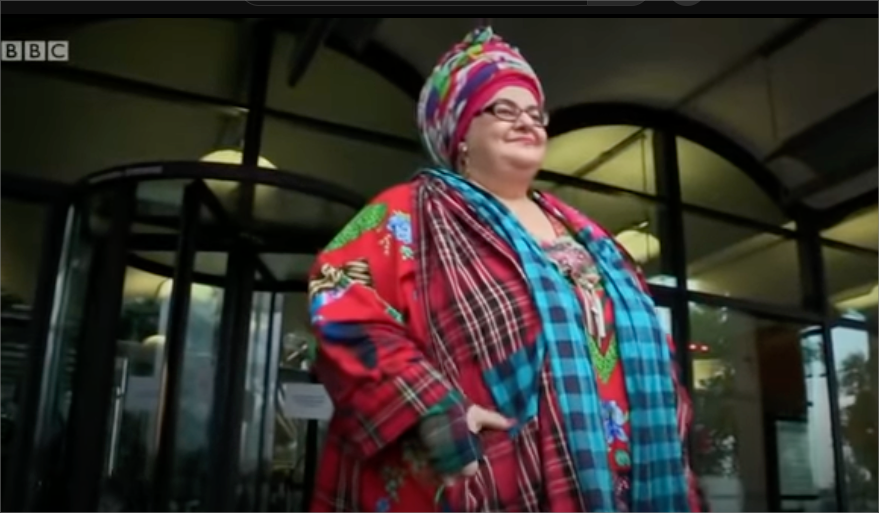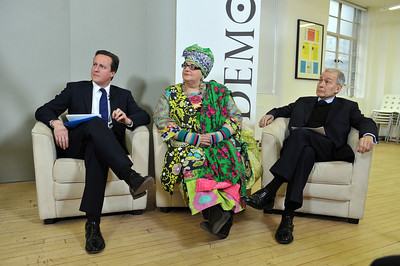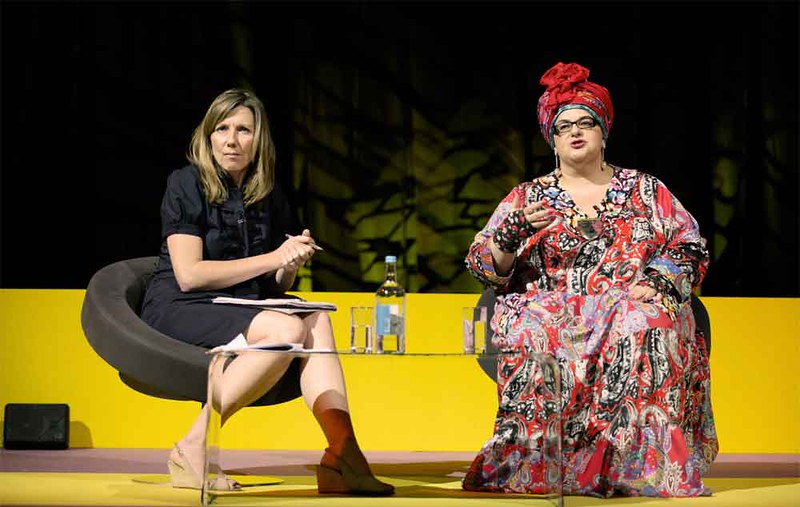
There’s a moment in Lynn Alleway’s documentary “Camila’s Kids Company: The Inside Story where Camila Batmanghelidjh emerges from a UK parliamentary grilling and the paparazzi are there, calling out her name as if they know her personally — “Camila! Camila!” — to get the best shot. Batmanghelidjh stands on the steps of the building, her smile wobbling. This moment would mark the end of her career as what one Labour MP called the “poster girl” for a new way of helping those in need. It also marked the beginning of the end of her life.
I explore her case to illustrate another chapter in “How Journalists Think“, with the question: Why does journalism tend to destroy those it once adored? How do these stories develop in the newsroom, and is it something that can be anticipated by those trying to protect those figures from public damnation?
Perhaps that’s too facile a way of putting it. Boiled down, the arc is this: Journalists are always looking for something — or someone — remarkable, that allow themselves to become, or courts the media in helping them become, a ‘celebrity’ figure. In a lot of cases the celebrity status is the end in itself, but it can also be a means to an end. For such people being a celebrity is a useful step in serving some other purpose — usually promoting something they are trying to sell. In the case of Batmanghelidjh, it was trying to sell a new approach in helping the disadvantaged to deep-pocketed politicians and high-net worth individuals (including celebrities.)
Squeeze out the anger
The story of Camila Batmanghelidjh is, briefly this (here’s a much better telling of her story): A Iranian-Belgian, she was educated in England and made it her home. She developed an approach for abused and damaged kids that was startlingly different to how others looked at them: embrace them, she preached. And she would, squeezing a lot of the anger and hatred out of those she worked with. She also believed in giving out cash: she was extremely generous with those she felt needed her largesse, arguing that having, not just basic necessities, but also nice things was part of restoring self-esteem.

UK PM David Cameron and Labour MP Frank Field with Batmanghelidjh, in Liverpool, 2010 (Demos, CC)
She made enemies from the get-go, but she also made powerful friends, and where she could she used those connections to draw funding, expanding her small charity in Peckham to a multi-million pound operation that at its height, she said, was looking after 36,000 ‘clients.’ She was showered with awards and high-profile photo-ops. Her fall from grace was fast: allegations of abuse piled onto allegations of financial mismanagement, and, although she and the charity were largely exonerated, that came too late to save either. Batmanghelidjh died on January 1, 2024, less than a decade after Kids Company had collapsed.
For a journalist there are five main phases to her story.
- Niche: interest is largely confined to specialist media and journalists covering poverty, inner cities, social benefits etc. Her dramatic profile may actually work against her at this point, because it may be considered frivolous and attention-seeking. A word like ‘controversial’ might be used in coverage, which can have both good and bad connotations. Being controversial means the subject is worthy of coverage in the journalists’ mind.
- Media Darling: As soon as she appears in public alongside senior politicians (including prime ministers and future kings) she enters a different kind of coverage, covered by a different kind of journalist. At this point she becomes a visual and written subject in her own right, and courting the media has advantages for both sides. She is able to attract funding on the back of this, and that in turn becomes part of her media appeal.
- Pivot point: She will also attract the counter-force by those questioning the veracity of her claims, and those journalists who spot a possibility of challenging the image she now has in the media. This is the point at which things could go either way. The investigative stuff will force other journalists to include language like “sometimes controversial” as they prod the edges of their previously positive coverage: given the established nature of the story words like “controversial” are no longer a good thing.
- The Slide from Grace: Momentum builds and if there’s enough material, the negative stories will pile up on one another inexorably. This is where Batmanghelidjh loses control of how she is perceived and gradually (and sometimes quickly) the tide will turn against her, and journalists who once wrote positively about her will fade away.
- Coup de grâce: This is when journalists draw a line under the story, where essentially the subject is covered with their name preceded by words like scandal-hit, disgraced, bankrupt and where that becomes the justification for the story. No longer is the subject able to affect how journalists cover the story. In Batmanghelidjh’s case, this period lasted from late 2015 to her death.
The demon of Peckham
I’m not saying that these are the only stories to be told, but a journalist swimming against the tide in any particular phase will find it a hard sell to editors. A journalist in the first phase would probably approach it as a visual story, as Batmanghelidjh was photogenic, charismatic and playful. This would help move the story from the ‘community’ pages to the more commanding ‘social’ pages. Likewise, once the negative reports start to ooze out it would be a brave journalist who might try to write a ‘yes, but’ story which presented Batmanghelidjh’s case that the charges were politically motivated and without substance.
Something worth noting here: a symbiosis can emerge where journalists find themselves in alliance with groups within the story. Batmanghelidjh won a lot of friends and attracted a lot of funding, but that in turn put noses out of joint, and may also have raised legitimate concerns about her work. The journalists who were first to follow up on sources or hunches that not all was as it seemed fed their findings to local councillors, creating a positive feedback loop in which both were emboldened to investigate claims.

Camila Batmanghelidjh plenary questions with Sarah Montague, NHS Confederation annual conference & exhibition 2011, creative commons
It’s instructive to watch the documentary to see how Batmanghelidjh handled all this. She courted Alleway, a documentary maker who had previously released a glowing documentary about her a decade earlier, to follow her and video the process by which she hoped to spike the guns of her detractors and turn her financial problems around. It’s clear early on that while she directs events as much as she can, she is severely underestimating the hole she is in, and even a sympathetic documentary maker starts to lose faith both that Batmanghelidjh will manage her conjuring trick — and that she is being wholly honest about where the money is going. It’s a painful ride. Batmanghelidjh seemed to grasp the Shakespearian dynamics of her story but not the need to take her detractors seriously: “It’s revenge, round one,” she tells Alleway. “They are about to murder the very thing that works.” And then, later: “They made me the angel of Peckham and now they’re going to make me the demon of Peckham.”
“This one is bad”
Batmanghelidjh does have a media strategist and head of PR, but it’s clear that he has little control over what Batmanghelidjh says or does — even, I sense, over whether he was consulted about allowing a documentary maker fly-on-the-wall access. His efforts to tighten whatever is coming out of the charity in emails and statements, let alone what is coming out of Batmanghelidjh herself, bear little fruit. Batmanghelidjh’s charisma and passion are not enough to save her when she is dragged before a parliamentary committee, conveying vagueness and umbrage in equal measure.
Could she and her advisors done better? Easy to say with hindsight, but it’s clear from one scene that the team is selective in which journalist it responds to. They struggle over a response to allegations that Batmanghelidjh’s driver has received significant funds despite his limited function, but even as the PR manager, Laurence Guinness, tries to prepare a statement Batmanghelidjh, painting her nails bright red, suggests they mention she uses another driver for other trips. Guinness is quick to scotch that, pointing out that “the bill for that runs into 30, 40,000 (pounds) a year…” Then a story comes through about a house with swimming pool that is being rented, and they look at the iPad together. “Oh no, this is the one that is bad, very bad,” he says. “I just ignored him.” And they decide to continue to ignore him.
The story is a fatal blow, and it would have been written with or without their being involved. And when the documentary maker is shown the house and swimming pool in question, it’s clear to both her and the audience that Batmanghelidjh’s description of the pool as tiny is incorrect. It is after this story that her credibility collapsed. There’s nothing really that Guinness could have done — although you might have hoped they would have realised early on in this part of Batmanghelidjh’s trajectory that losing the house might have been a good move.
The truth is that once the tide turns nothing can stop it. Soon after one or two stories land other journalists will be under pressure to distance themselves from previous glowing stories about her, either by staying quiet or by finding ones that float with the turning tide. A good PR would be asking for keys to the skeleton cupboard to anticipate what story might be next, and threaten to walk if the keys aren’t provided. But when your boss, rather than the organisation, is the story, that’s often hard to do. But at least recognising the warning signs of a turning tide might help you be better prepared. A fly-on-the-wall documentary maker might seem like a good idea, but even if they produce something sympathetic, it’s not going to be done in a timeframe that helps, and it may anyway not help move the needle.
Charisma and elbows
This is another reason why I am not a fan of PR thinking up, or thinking in terms of, ‘narratives’ for their clients. Batmanghelidjh at her best was a great story, because she challenged so many orthodoxies. Her charisma attracted political patrons who sought to capture some of that charisma, so a photo of her sitting next to Prime Minister David Cameron in the cabinet room at 10 Downing Street is media gold. The reality behind the picture is a little different: Batmanghelidjh was enticed into that chair and for her the meeting itself lacked substance. She found the wives of political figures much more in tune with what she was trying to do. But those contacts enabled her to short-circuit usual funding routes and attract both large-scale grants as well as envy, disdain and grudges from those elbowed out to make way.
A journalist will see what they want to see, and it’s a PR person’s job to try to shape that. They will follow closely the 4 steps I’ve listed above, and any attempt to alter that substantially will fail. What can be done is to recognise both the advantages and pitfalls of allowing a charismatic leader to overshadow the organisation they are fronting. In many cases this is impossible. But by allowing media and leader to dance together into the stratosphere, there is only one way left to go, and that’s down. For one thing it makes both founder and organisation hostage to fortune: the more successful they are, the sooner the organisation will need more professional hands running it, creating a well-known challenge called founder syndrome. In Batmanghelidjh’s case it was obvious within a few seconds of the documentary beginning that she presided over something that had become a monster — miles of expensive office space, lots of employees at computers more redolent of a blue chip company than a scrappy NGO — and that her fate was sealed.
Better counsel would be to gradually limit media access to Batmanghelidjh herself and focus on the more professional side of the company, making scale the next version of the story, and the calibre of those being brought in to help. In other words, a more solid strategy would be to dial down the story about Batmanghelidjh and dial up the story about scale and next steps — and to start strategising what negative stories journalists might be looking for and help to neutralise them. Frankly, ignoring a journalist asking about a negative story never ends well as we’ve discussed before.
Do journalists feel bad about what they do? Some. It’s not a nice feeling to see someone you’ve written about impacted by your story, even if the story was the truth and a corrective to public perceptions. I’ve had the daughter of a prominent figure I wrote an exposé about weeping as she asks me why I hated her father so much. We always say it’s not personal, but it sometimes is. One journalist who led the investigative work which started the unravelling, Chris Cook, wrote on Twitter after her death that “61 is no age, and she was gifted at dealing with tough young people – but should not have got £40mn+ in public funds.” Perhaps unsurprisingly, the tweet prompted some strong responses.
Journalism is never definitive. It’s always the best effort at the time, in the time allowed. I suspect that at some point attention will return to her ideas, laid out in several books, and she will be regarded as a visionary of sorts. Unfortunately there’s no room for that kind of journalism until we build a decent time machine.